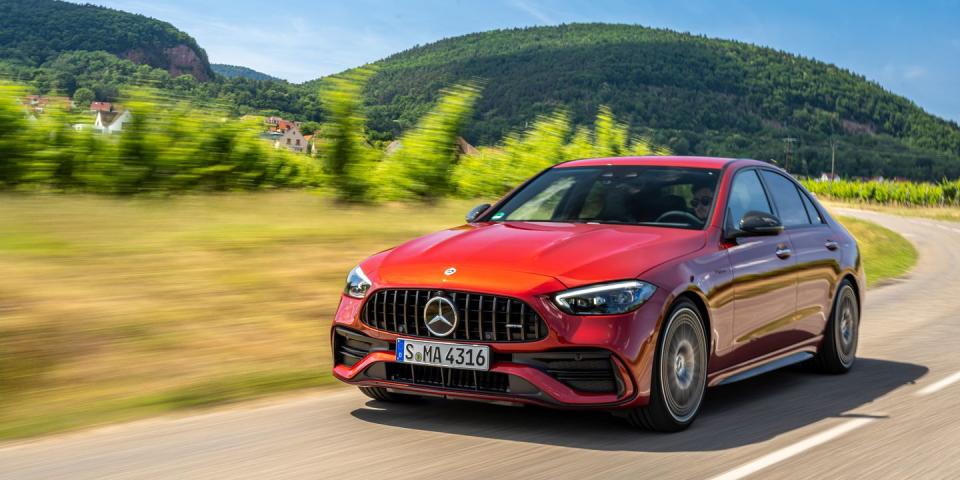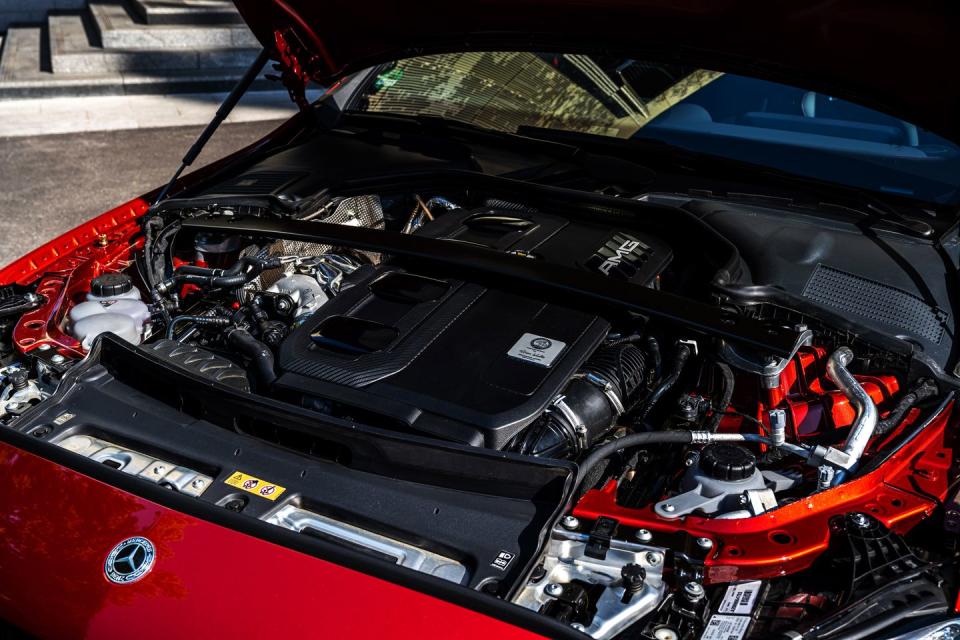2023 Mercedes-AMG C43 Has Less Engine, More Power

Before anyone assembles an angry mob and breaks out the pitchforks in response to this latest example of engine downsizing—a twin-turbo V-6 displaced by a turbo four in the 2023 Mercedes-AMG C43—know that we have been here before. AMG has been producing four-cylinder engines since 2013, although fitting them transversely to cars like the dinky GLA, CLA, and A-class rather than north-south as in the new C43.
Looking further back, Mercedes has even produced a four-cylinder performance derivative of one of the C43's direct descendants, the stylish 190E sedan, which got 2.3- and 2.5-liter versions fitted with Cosworth-designed 16-valve cylinder heads in the 1980s. But while the 2.5-16 made 195 horsepower, the new C43's turbocharged 2.0-liter four unleashes 402 horses.
So, it must be more than twice as good, right?
The new engine effectively replaces the 3.0-liter twin-turbocharged V-6 of the last-generation C43. It has lost cylinders and capacity but not power, using an advanced electrically assisted turbocharger to beat its predecessor's peak output (although the maximum 369 pound-feet of torque is lower). The turbo, built by Garrett Motion, uses a compact electric motor between the turbine and the compressor that acts directly on the shaft. It can add a claimed 6 kW of assistance and spin at speeds of up to 170,000 rpm. It can also harvest a small amount of energy from gas flow, although only fleetingly. More regen comes from a 48-volt belt-integrated starter-generator that can also add modest levels of assistance at lower speeds.

The turbo's e-motor allows boost to build even when exhaust gas isn't flowing, to help reduce response delay. In the C43's more aggressive dynamic modes, it will also keep the blades spinning when the throttle is lifted. It's essentially an electric version of the pop-bang anti-lag that makes rally cars sound like a shooting range. As in the brawnier AMG models, the nine-speed automatic gearbox uses a wet clutch rather than a torque converter to improve response. The standard all-wheel-drive system has a permanent torque split of 31:69 front to back, and rear-wheel steering and active dampers are both standard.
While the new C43's engine is more sophisticated than its predecessor, it's less charismatic. The exhaust note is entirely in keeping with a potent four-cylinder engine, managing some pops and chuckles when the throttle is lifted, although some of that is digitally enhanced through the audio system. But it's much more muted than previous AMG models, even when being pressed hard, and it fades to imperceptibility at cruising speeds.

The electric turbo makes its contribution almost invisibly. It is possible to hear an enhanced induction whine at lower speeds as the turbo builds boost even when the engine is only turning slowly. Pushed harder, throttle responses are indeed clean and lag-free, with no hint of delay even when lifting off and reapplying the gas rapidly. Yet despite its boosted booster, the new engine isn't especially keen to rev. The car we drove in France hit its spark-cut limiter shortly before the marked 7000-rpm redline, and it shifted a good 500 rpm shy of that point with the transmission left in Drive. While the autobox swaps cogs smoothly and intelligently, there was a noticeable pause when requesting manual downshifts via the steering-wheel paddles.

 Yahoo Autos
Yahoo Autos 